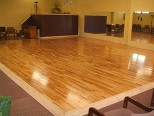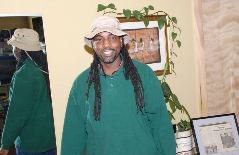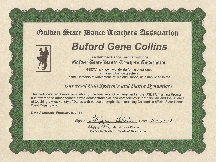The Urban dance known as Detroit Ballroom is a variation of the Afro-Cuban dance known as CHA-CHA-CHA. Detroit's Ballroom has an 8 count basic pattern. This is equal to 2 measures of music in 4/4. Its tempo ranges 90 to 120 bpm. Its basic rhythm pattern consists of two doubles and two rolling triples. The patterns start traditionally on the downbeat of one with a forward step. The leader's footwork is normally started on their right and finished on their left if the dance is started in side by side Skaters' promenade. The follower dances alike; as leaders advance they learn a left foot start also considered natural opposite. The Detroit Ballroom can be danced circular or slotted. It is characteristically seen as circular more often than slotted in social settings. Take into consideration the term Detroit Ballroom began to be used between late 1980's & 1990's to express this dance. The dance known has Detroit Ballroom is more likely a derivative of Cha-Cha.
No published syllabuses exist for the dance. ~ Mistalocks
All Rights Reserved©
The Urban dance known as Walkin' smooth graceful dance known for it's counter clockwise line of dance. The dance is dance to 4/4 and 6/8 misc geneses that have a Blues compositions. Walkin' is an 8 count basic pattern and uniquely enough also a 12 count pattern dance to music in 6/8, this makes Walkin' equal to 2 measures of music in 4/4 and 2 measures in 6/8.
Its tempo ranges 66 to 78 bpm in 4/4, while it's tempo range 100 to 120bpm in 6/8. Its basic rhythm pattern consists of two doubles and two singles when dancing in 4/4, and in 6/8 the dance uses two doubles, two singles, two blanks as its units. The pattern starts traditionally on the downbeat of one with a forward step. The leader's footwork is normally started on their left and finished on their right and follower dances natural opposite of the leader or alike if using a side by side promenade. Walkin' is dance traditionally in a closed embrace, but can and does use figures that need an open embrace to be executed and side by side promenade.
No published syllabuses exist for the dance. ~ Mistalocks All Rights Reserved©
Mistalocks' instructional format is based on understanding dance through understanding music. The classes teach based on counting music to build your dance. Below is an example of how the class is formatted.
Includes:
· Counting music
· Understanding a musical phrase
· Introduction to rhythm pattern and its count
· Choreographing a 32 beat phrase
· Application and assessment
Counting Music
We will be accessing the time signature of songs for the dance genre and counting the musical measures to determine time.
Understanding a Musical Phrase
Our songs usually have a mini phrase that is two measures or 8beats. The phrase is a small musical thought that adds to the whole musical composition.
Introduction to rhythm pattern and it count
Rhythms are patterns and our goal is to establish the dance pattern and measure it against the music.
Choreographing a 32 Beat Phrase
It is time to put our dance to the music. The dance will tell a story that isn't very long but can be expressed with a lot of thought and feeling. The dance paragraph or major phrase measure will equal in time to 32 beats of music presented. This will allow the instructor to easily assess errors in the Student's performance.
Application and Assessment
Once the 32 beat phrase amalgamation is complete the students must go through application of the choreography.The application will allow the instructor to assess the Student's ability to execute each individual figure of the choreography and to maintain the overall timing of the choreography. It would also allow instructors to watch the partner work between students. Each cycle of the amalgamation will allow the instructor to critique the students on different aspects of their individual dance and partnership. The assessment should be kept simple and follow the training procedures and structures the instructor has set for maintaining the quality of class.

The Urban dance known as Graystone is a variation of the Box Rhythm Foxtrot. This smooth graceful dance known to some Detroiter dancers also as "Social" has an 8 count basic pattern. This is equal to 2 measures of music in 4/4 and its tempo ranges 90 to 140 bpm.
Its basic rhythm pattern consists of two singles and two doubles. The pattern starts traditionally on the downbeat of one with a forward step. The leader's footwork is normally started on their left and finished on their right and the follower dances natural opposite.
The Graystone is danced traditionally in a closed embrace, but can and does use figures that need an open embrace to be executed. Its line of dance would be counter clockwise if the community of dancers maintained the tradition inherited from the Foxtrot. Take inconsideration the term Graystone is the name of one of Detroit's popular Ballrooms that is now closed and demolished. The traditional ballroom style dances were present at the time and no written documentation has ever been presented to document a history of the dance known as Graystone.
No published syllabuses exist for the dance. ~ Mistalocks All Rights Reserved©
No published syllabuses exist for the dance. ~ Mistalocks All Rights Reserved©
The swing dance known as Detroit Bop is a part of the EASTERN SWING family. Detroit's Bop has a 6 count basic pattern. This is equal to 1 1/2 measures of music in 4/4 and the tempo ranges between 100 to 120 bpm.
Its basic rhythm pattern consists of a delayed double and two rolling triples.
Detroit Bop dancers know as "Boppers" start dancing traditionally on the downbeat of one with a kick.
The leader's footwork is normally started on their left and finished on their right and the follower dances natural opposites of the leader.
Detroit Bop can be danced circular or slotted, yet it's characteristically seen as circular more often than slotted in social settings.
Take inconsideration the term Bop began to be used between 1945 & 50 to express music and dance.
The dance known has Detroit Bop is more likely a derivative of Jitterbug.
No published syllabuses exist for the dance. ~Mistalocks All Rights Reserved©




